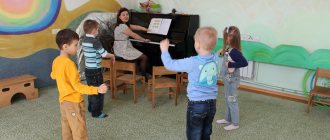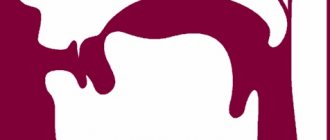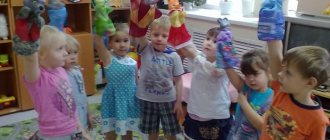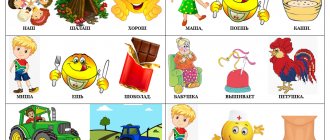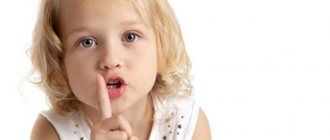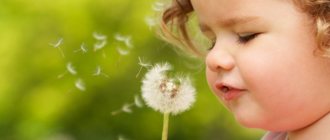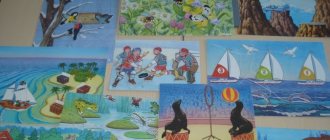The use of facial gymnastics when conducting speech therapy classes is an integral part of the work on setting and correcting sounds in children with various pronunciation disorders (general insufficient speech development, delayed speech development, dysarthria, stuttering, etc.). Facial gymnastics for children and articulation exercises, which speech therapists use when working with preschool children, make it possible to prepare muscles and nerve endings for further work on producing sounds, clear diction, and more precise movements of the articulatory apparatus during speech. They help prevent the development of unnatural articulatory movements, allow you to relax the muscles of the face, and train the use and control of the muscles of the tongue, lips, and palate. These goals are pursued by both static and dynamic exercises.
Recommendations
To get a good result, you must follow a number of recommendations:
- Perform all exercises in front of a mirror. Ideally, this should be a large mirror in which the preschooler will see both himself and the speech therapist;
- focus on only one muscle group when performing an exercise;
- perform the exercises smoothly, rhythmically and calmly, without making significant effort.
Below are various exercises, the purpose of which is to develop and strengthen facial muscles with step-by-step descriptions.
Relaxation mood
"Air balloons"
Imagine that you are all balloons, very beautiful and cheerful. They cheat you and you become lighter and lighter. Your whole body becomes light and weightless. And the arms are light, and the legs have become light, light. The balloons rise higher and higher. A warm gentle breeze is blowing, it gently blows on each ball... (pause - stroking the children). Blows on the ball..., caresses the ball... You feel at ease, calm. You fly where the gentle breeze blows. But now it's time to return home. You are back in this room. Stretch and on the count of three, open your eyes. Smile at your balloon.
"Clouds"
Imagine a warm summer evening. You lie on the grass and look at the clouds floating in the sky - such white, large, fluffy clouds in the blue sky. Everything around is quiet and calm, you feel warm and comfortable. With each inhalation and exhalation, you begin to slowly and smoothly rise into the air, higher and higher, towards the very clouds. Your arms are light, light, your legs are light. your whole body becomes light as a cloud. Here you are swimming up to the largest and fluffiest, most beautiful cloud in the sky. Closer and closer. And now you are already lying on this cloud, you feel how it gently strokes you, this fluffy and tender cloud... (pause - stroking the children). Strokes..., strokes... You feel good and pleased. You are relaxed and calm. But then a cloud dropped you into the clearing. Smile at your cloud. Stretch and on the count of three, open your eyes. You had a good rest on the cloud.
“Lazy People”
Today my children did a lot of activities, played and were probably tired. I suggest you be a little lazy. Imagine being lazy and lounging on a soft, soft carpet. Everything around is quiet and calm, you breathe easily and freely. A feeling of pleasant peace and relaxation covers your entire body. You rest quietly, you are lazy. Your hands are resting, your legs are resting... (pause - stroking the children). Your arms are resting..., your legs are resting... Pleasant warmth covers your whole body, you are too lazy to move, you feel good. Your breathing is completely calm. Your arms, legs, whole body are relaxed. A feeling of pleasant peace fills you from within. You rest, you are lazy. Pleasant laziness spreads throughout the body. You enjoy complete peace and relaxation, which brings you strength and good mood. Stretch, shake off your laziness and, on the count of three, open your eyes. You feel well rested and in a cheerful mood.
"Waterfall"
Imagine that you are standing near a waterfall. Wonderful day, blue sky, warm sun. The mountain air is fresh and pleasant. You can breathe easily and freely. But our waterfall is unusual; instead of water, soft white light falls in it. Imagine yourself standing under this waterfall and feel this beautiful white light flowing over your head. You feel it pouring over your forehead, then over your face, down your neck... White light flows over your shoulders... helping them become soft and relaxed... (pause - stroking the children). And the gentle light flows further along the chest of..., along the stomach of... Let the light stroke your hands and fingers. The light flows through your legs and you feel how your body becomes softer and you relax. This amazing waterfall of white light flows around your entire body. You feel completely calm, and with each breath you relax more and more. Now stretch and on the count of three, open your eyes. The magical light filled you with fresh strength and energy.
"Puffing up the cheeks"
Puffing out our cheeks:
- “fat tomatoes” - puff out our cheeks;
- “skinny parsley” - suck in the cheeks;
- alternately inflate the right and then the left cheeks;
- round your mouth as when pronouncing the sound “o”;
- stretch out your lips with a tube;
- wrinkle your nose and say “ugh” in a whisper;
- smile showing closed teeth
You can do exercises with a child (or a group of children) in a playful way. The game will interest them more than simply performing movements in front of the mirror. Below are a few such games.
Relaxation exercises to relieve tension from facial muscles.
"Smile"
Imagine that you see in front of you in the picture a beautiful sun, whose mouth has spread into a wide smile. Smile back at the sun and feel how the smile goes into your hands, reaching your palms. Do it again and try to smile wider. Your lips stretch, the muscles of your cheeks tense... Breathe and smile..., your arms and hands are filled with the smiling power of the sun (repeat 2-3 times).
“Sunny Bunny”
Imagine that a sunbeam looks into your eyes. Close them. It ran further down the face. Gently stroke it with your palms: on the forehead, on the nose, on the mouth, on the cheeks, on the chin. Stroke gently so as not to frighten the head, neck, tummy, arms, legs. He climbed up the collar - pet him there too. He is not a mischievous person - he catches and caresses you, and you pet him and make friends with him (repeat 2-3 times).
"Bee"
Imagine a warm, summer day. Expose your face to the sun, your chin will also sunbathe (unclench your lips and teeth as you inhale). A bee is flying, about to land on someone's tongue. Close your mouth tightly (hold your breath). When chasing away a bee, you can vigorously move your lips. The bee flew away. Open your mouth slightly and exhale lightly (repeat 2-3 times).
"Butterfly"
Imagine a warm, summer day. Your face is tanning, your nose is also tanning - expose your nose to the sun, your mouth is half open. A butterfly flies, chooses whose nose to sit on. Wrinkle your nose, raise your upper lip upward, leave your mouth half open (hold your breath). To chase away the butterfly, you can vigorously move your nose. The butterfly flew away. Relax the muscles of the lips and nose (as you exhale) (repeat 2-3 times).
"Swing"
Imagine a warm, summer day. Your face sunbathes, the gentle sun caresses you (facial muscles are relaxed). But then a butterfly flies and lands on your eyebrows. She wants to swing like on a swing. Let the butterfly swing on the swing. Move your eyebrows up and down. The butterfly has flown away, and the sun is warming (relaxation of the facial muscles) (repeat 2-3 times).
Game "Masks"
Various game options are possible.
Equipment: masks depicting various emotions (sadness, joy, surprise, boredom, melancholy, fear), as well as fairy-tale characters.
First option
The teacher puts on the masks one by one (or simply shows them) and asks them to repeat the facial expression depicted on the mask and name it. The actions are accompanied by explanations from the teacher.
Questions to discuss the game:
- What emotions do you most often observe in your friends (mother, grandmother, teacher, passers-by)?
- Are you pleased to see these emotions yourself?
Second option
The speech therapist invites preschoolers to name the facial expressions of familiar characters from fairy tales:
- What is Barmaley's facial expression?
- What kind of bun is it?
- Imagine that you have become a kind Santa Claus (the sad Princess Never Laughed). What is his facial expression?
Third option
The group is divided into two parts. One decides which fairy-tale character she will show, and the second must guess from her facial expressions who the children are portraying. Then they change places.
Relaxation exercises to relieve tension from the muscles of the torso, arms, legs.
“Sleeping kitten”
Imagine that you are cheerful, mischievous kittens. Kittens walk, arch their backs, and wag their tails. But the kittens got tired...they started yawning, lay down on the mat and fall asleep. The kittens' bellies rise and fall evenly, they breathe calmly (repeat 2 - 3 times).
“Bumps”
Imagine that you are cubs and your mother bear is playing with you. She throws bumps at you. You catch them and squeeze them forcefully in your paws. But the cubs are tired and drop their paws along the body - the paws are resting. And the mother bear again throws cones to the cubs... (repeat 2 - 3 times).
“Cold - hot”
Imagine that you are playing in a sunny meadow. Suddenly a cold wind blew. You felt cold, you were frozen, you wrapped your arms around yourself, pressed your head to your hands - you warmed up. We warmed up, relaxed... But then the cold wind blew again... (repeat 2-3 times).
“Sun and Cloud”
Imagine yourself sunbathing in the sun. But then the sun went behind the cloud, it became cold - everyone huddled together to warm up (hold their breath). The sun came out from behind the clouds, it became hot - everyone relaxed (as they exhaled). Repeat 2 – 3 times.
"Jewel"
Imagine that you are holding something very valuable and dear to you in your fists and someone wants to take it away from you. You clench your fists tighter and tighter... even tighter, your bones have already turned white, your hands begin to tremble... But the offender has left, and you unclench your fists, your fingers become relaxed, your hands lie calmly on your knees... they are resting... (repeat 2-3 times ).
“Playing with sand”
Imagine that you are sitting on the seashore. Pick up sand in your hands (as you inhale). Clenching your fingers tightly into a fist, hold the sand in your hands (hold your breath). Sprinkle sand on your knees, gradually opening your hands and fingers. Let your arms fall powerlessly along your body, too lazy to move your heavy arms (repeat 2-3 times).
"Ant"
Imagine that you are sitting in a clearing, the sun is gently warming you. An ant crawled onto my toes. Pull your socks towards yourself with force, keep your legs tense and straight. Let's listen to which finger the ant is sitting on (holding your breath). Let's throw the ant off our feet (as we exhale). Socks go down - to the sides, relax your legs: rest your legs (repeat 2-3 times).
Silent movie
The Silent Movie game is also available in several variations:
The speech therapist “turns” into a TV that has no sound, and asks you to guess from his gestures and facial expressions what he wants to say (praises, scolds, rejoices, gets scared, points to an object, asks to bring it or take it away, calls someone... either to himself or asks to leave). After this, the children and the teacher change roles.
- Preschoolers are divided into two groups. They must imagine that they are standing on different banks of a very stormy river. The first group is given the task of “telling” without words those standing opposite that they need to hide, as they are in great danger.
- Children should show fear, joy, fatigue, anger, surprise with one gesture or facial expression.
Rules for performing facial gymnastics
You can do facial gymnastics for children even at home, with your mother or another adult. In this case, you need to follow the recommendations.
- Classes are held daily, for 5-10 minutes.
- First, parents need to master the exercise themselves in order to show it to their child.
- The baby should be calm and comfortable. It is important that he feels good.
- For practice you will need a fairly large mirror. It is necessary for the child to see how he performs the exercise. A mirror is also needed to observe an adult who is doing the exercise next to him.
- It is not the quantity of exercises done that is important, but their quality.
- The tongue, lips or jaw should not tremble from tension. It is necessary that the movements occur calmly, without jerking.
- First, they perform a set of static exercises, then proceed to dynamic ones.
- In dynamic exercises, transitions between movements are made quickly and smoothly.
- The exercises are repeated 3-5 times, then take a short break. After this, you can start the task again.
- To make classes interesting, you should use colorful pictures or dolls with clear, expressive facial expressions.
- If a child is unable to do an exercise, you should put it off for a while, but then be sure to return to it.
- It is important to praise your child and celebrate his successes.
- You can’t scold your child if something doesn’t work out for him.
"Name Day"
Two versions of the “Name Day” game:
- Children stand in a circle and choose one birthday person. The rest play the role of donors. The birthday boy decides what kind of fairy-tale character he wants to be and tells the others about it. The givers decide which character the gift would be suitable for (the character can be either magical or real), then without words, using only gestures and facial expressions, they present it to the birthday person. The birthday boy must guess what the gift is and thank him. Children take turns playing the role of the birthday boy.
- The birthday boy decides for himself what kind of fairy-tale hero he will be, but does not tell anyone. With facial expressions and gestures he tries to communicate the chosen role. The teacher invites the children to guess who their friend is portraying and what they can give him.
Question after the game:
Which gift did the hero like best?
Choosing the right gymnastics
Usually, to correct speech, you need to use various types of speech therapy gymnastics. This will allow you to cope with speech disorders as quickly and effectively as possible.
By combining articulatory and facial gymnastics, you can teach your baby to keep his facial and articulatory muscles in good shape, develop their smoothness, mobility and strength. This will improve your pronunciation, fluency and diction.
It is worth consulting with a speech therapist so that he can select a suitable gymnastics complex for your child.
Facial gymnastics classes are suitable for those children who have poor command of the facial muscles and articulatory apparatus. Exercises will help develop facial expressions and improve speech. To achieve the best effect, it is recommended to use facial gymnastics in combination with articulation.
If you liked the article, please share a link to it
"Shapes"
Two groups of children. One portrays a famous magical character, and the second tries to find out who their comrades are showing. Then they change places. You can also depict various emotions, and not just fairy-tale characters (a joyful, sad, frightened person). According to the terms of the game, “Figures” are exhibits in a museum. But if you correctly guess who is depicted, the figure comes to life.
The variety of techniques, exercises, and games used to develop and strengthen facial muscles is quite large. Unfortunately, they cannot fit into one short article. With almost every articulation exercise, you can use poetry to make the child more interested and involved. It is important to understand that only systematic classes conducted by an experienced speech therapist, supported by the work of preschool teachers, as well as the homework of parents and their baby, bring good results.
Mimic gymnastics
Facial gymnastics is a type of speech therapy gymnastics in which facial muscles and facial movements develop.
Such exercises keep facial muscles toned and teach you how to control your tongue, lips and palate.
Classes can begin from preschool age, from about 3-4 years. It is during this period that the first signs of speech disorders are discovered.
To correct stuttering, delayed speech development, and incorrect sound pronunciation, it is recommended to perform these exercises in combination with articulatory gymnastics.
On the topic: methodological developments, presentations and notes
Young children (due to their age) are not able to cope with a large number of emotions, which significantly complicates the process of learning about the world around them. Therefore, the main task is to...
Summary of an integrated lesson on speech development, with musical elements, based on health-saving technologies (psycho-gymnastics, facial gymnastics, relaxation).
This material is intended for practicing speech therapists and parents of children suffering from dysarthria.
Facial gymnastics helps in developing mobility and strengthening facial muscles. With systematic, correct and long-term performance of facial exercises, children are better able to do many words.
Memo for parents “Mimic gymnastics for children.”
The manual reveals: why facial gymnastics is needed, recommendations for performing facial gymnastics, exercises for the development of facial muscles (purpose, description, poem, visual image.
The need to develop these movements is due to the fact that children suffering from various forms of dysarthria have weak tone of the facial muscles, inexpressive facial expressions, etc.
Source
On the topic: methodological developments, presentations and notes
Young children (due to their age) are not able to cope with a large number of emotions, which significantly complicates the process of learning about the world around them. Therefore, the main task is to...
Summary of an integrated lesson on speech development, with musical elements, based on health-saving technologies (psycho-gymnastics, facial gymnastics, relaxation).
This material is intended for practicing speech therapists and parents of children suffering from dysarthria.
Facial gymnastics helps in developing mobility and strengthening facial muscles. With systematic, correct and long-term performance of facial exercises, children are better able to do many words.
Memo for parents “Mimic gymnastics for children.”
The manual reveals: why facial gymnastics is needed, recommendations for performing facial gymnastics, exercises for the development of facial muscles (purpose, description, poem, visual image.
card index for senior preschool age.
Source
